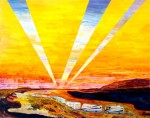Question 5: Editing – What do you choose to include in the final product? How do you choose this?
Lotte:
What does a documentarian choose to include in the final product and why? What does is look like? How can documentary transform into another medium? How do you document the unrepresentable? How does the imagination influence documentation?
“Some people think that this is more dramatic than the photos, and perhaps it is true because, when you paint, everything that is not necessary, you let out. You go to the essence of… the subject.” F. Botero
Works of art about – and inspired by – documentation, such as painting, animation, drawing, and installation, eloquently address the essence of a subject. Because each piece of documentary addresses editing – and the role of editing was our original question, I reached a more focused question: how can documentary transform content, and what do these transformations mean; how a piece of footage can find an alternative meaning in what it is trying to document – perhaps finding a new meaning because it addresses something that cannot be said with traditional documentary forms.
The role of the imagination in documentary is addressed when we see much of this work – something that is challenging and thought-provoking. I focused on specific narratives relating clearly to ethics, politics, revolution and human rights alongside the imagination – such as work by William Kentridge, addressing Apartheid in South Africa, Lisa Sanditz’s paintings about Chinese factories, such as Sock City, Fernando Botero’s photographs of Abu Ghraib, Gerhard Richter’s September series addressing 9/11, Marjane Satrapi’s Persepolis about the Iranian Revolution, Alfredo Jaar’s installation about Kevin Carter’s controversial photograph – and subsequent death, along with a few others. Though many of these projects talk about very different subjects, with differing theses, they all address serious content with imagination, emotion and creativity. Therefore, they often also distill the content and reach new conclusions.
These questions – and resulting pieces – that seek to answer the questions are compelling in the context of the entire group project, because there was a more direct focus on traditional documentary in most of the pieces. By addressing the imagination and alternative forms of documentation, we found an abstracted and less literal analysis of documentation – one incorporating beauty, surrealism and obscured meaning.
William Kentridge – Animation – Apartheid
Jeff Wall – Photography/Painting
Alfredo Jaar – Kevin Carter
Chris Marker – Sans Soleil
Other footage: James Nachtweh, War Photographer, Marjane Satrapi, Persepolis









